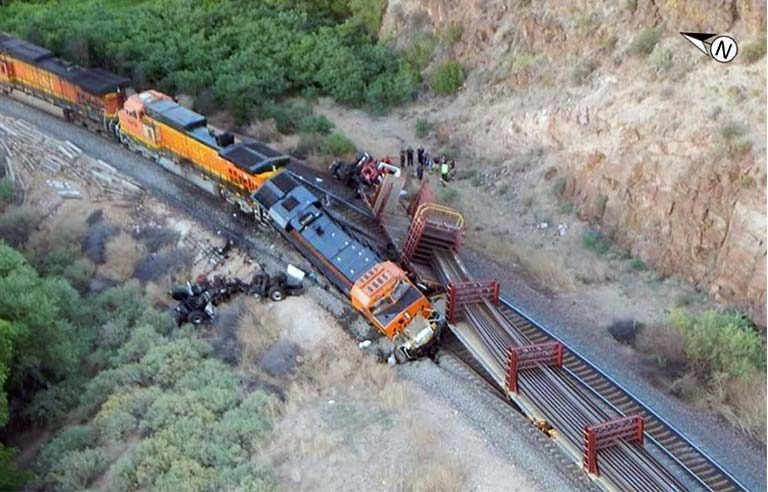NTSB: Speeding, ‘misinterpretation of requirements’ led to 2018 fatal train collision

Washington — A railway crew’s failure to operate within safe speed requirements and the Federal Railroad Administration’s interpretation of a safety regulation were factors in a fatal collision between a BNSF intermodal train and a work train in 2018, the National Transportation Safety Board has concluded.
The incident occurred in June 2018 near Kingman, AZ. During its investigation of the incident, which resulted in a worker’s death and left another seriously injured, NTSB found that the intermodal train crew “operated at a speed that did not allow their train to stop within half the range of vision as required.” The train was descending a 1.5% grade at a top speed of 15 mph while the work train was traveling about 9 mph up the grade and near a sharp curve in an area known as Crozier Canyon.
The collision occurred when the westbound BNSF train, operating in a centralized traffic control territory, hit the rear of the eastbound work train, which was moving in reverse to drop off an employee before traveling west to exit the main track.
NTSB concluded that training and oversight by railroad supervisors are ineffective in ensuring the operating crew’s use of restricted speed.
The Federal Railroad Administration regulation 49 CFR Part 214 Subpart C requires roadway workers who lay track to use a form of on-track safety, NTSB says in a May 20 press release. However, FRA’s interpretation of its regulation allows railway workers on work trains to lay track without using a form of on-track safety. This interpretation, according to NTSB, contributed to the collision.
“It is extremely important the railroad industry is in full compliance with established federal regulations,” said Robert Hall, director of NTSB’s Office of Railroad, Pipeline and Hazardous Materials Investigations, said in the release. “There is no room for misinterpretation of the requirements, as this tragic accident demonstrates. Regulations designed to protect railroad workers must be clear to avoid any ambiguity and eliminate risks.”
According to NTSB, it investigated eight incidents in 2020 that involved railroad and transit worker fatalities. When the agency released its 2021-2022 Most Wanted List of Transportation Safety Improvements in April, it included “Improve Rail Worker Safety” as one of the 10 items.
Post a comment to this article
Safety+Health welcomes comments that promote respectful dialogue. Please stay on topic. Comments that contain personal attacks, profanity or abusive language – or those aggressively promoting products or services – will be removed. We reserve the right to determine which comments violate our comment policy. (Anonymous comments are welcome; merely skip the “name” field in the comment box. An email address is required but will not be included with your comment.)

